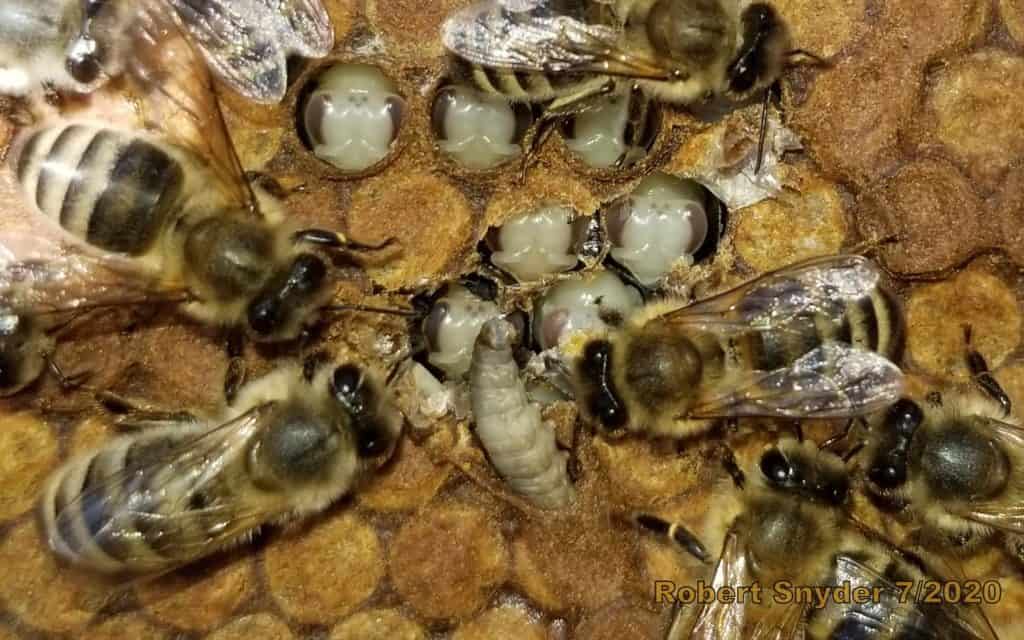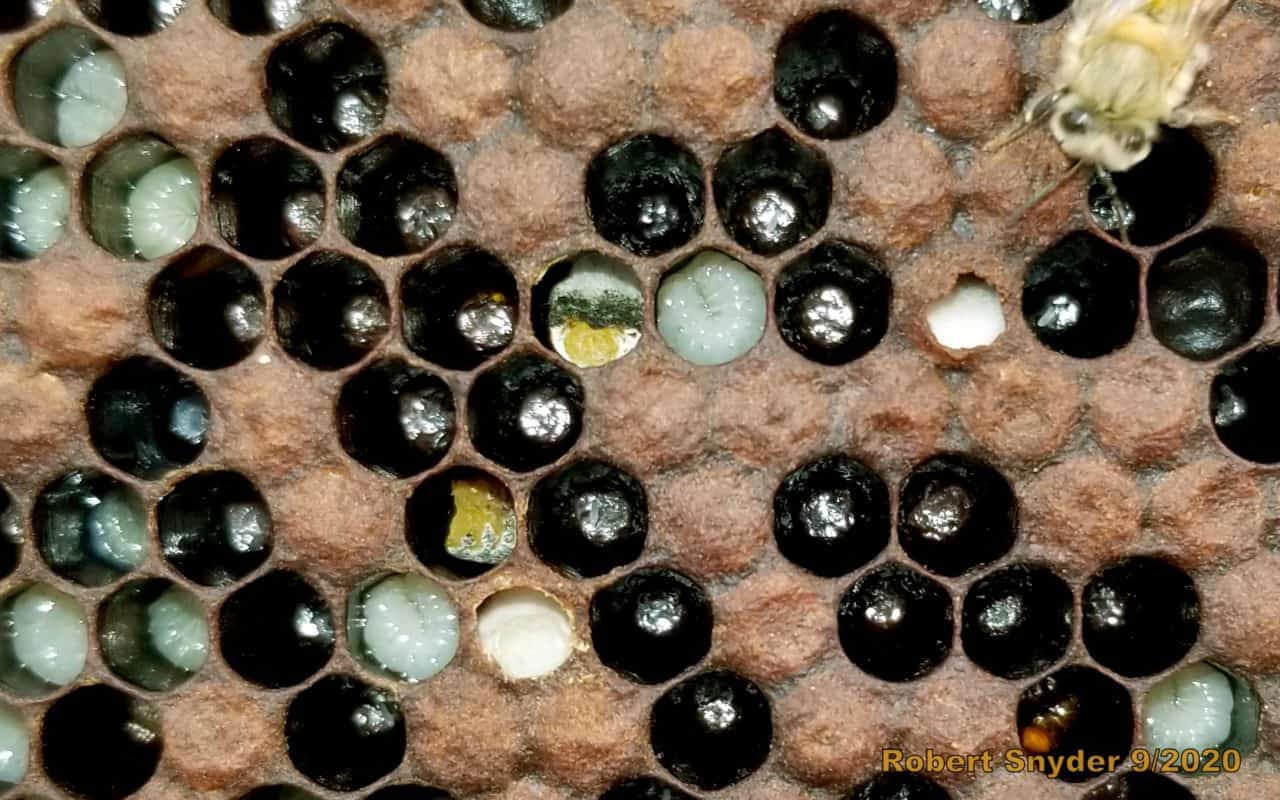As a honeybee health field specialist, when I am assessing a colony's health I look for irregularities in the sealed or open brood (Image 1 & 2). These irregularities may indicate the presence of diseases or pests. One common pest that can cause brood irregularities is the wax moth. Wax moth larvae develop underneath the honey bee colony's brood cappings. The wax moth larvae often bind a honey bee pupa’s feet to the midline of the of frame, resulting in pupae that are not able to molt properly and therefore die in the capped cell before emergence. When identifying and locating wax moth larvae in…
Category: Cool Entomology
Chalkbrood Disease Primer
When I started inspecting colonies for honey bee diseases in Pennsylvania in 2008, the first and most prevalent disease I found was chalkbrood. I observed this disease a few weeks into the spring season while inspecting a few colonies. I had seen the disease on several other occasions, so it was very easy to identify by the hard “chalk-like” mummies inside the cells. Ascosphaera apis is the fungus responsible for this bee disease. The exact origin of chalkbrood is unknown, but it most likely arrived from Europe with the alfalfa leafcutter bee (Megachile rotundata), when the bee species was introduced to assist with pollination demands…
More Five Dollar Bee Words
I am fortunate to spend a lot of time reading and listening to a lot of beekeeping and bee science topics which inevitably leads to coming across terms I have to look up. A couple years back I compiled a list of these challenging words and turned it into a Five Dollar Bee Words blog. Since that post I've continued to encounter words that have sent me to the dictionary so I've put together another list. Chorion is the flexible membrane surrounding honey bee eggs that is absorbed as the egg grows into a larva. Dioecious plant species have a separation of male (pistil) and…
Five Dollar Bee Words
I came to the world of bees by accident and had no bee-specific knowledge or training prior to becoming a beekeeper. Prior to working with Bee Informed Partnership (BIP), I spent 8 years as a commercial beekeeper where I gained a good understanding of bee behavior and management from practical experience. Since joining BIP, the exposure to colleagues and scientists has led to a lot of “lightbulb” moments where an unfamiliar word was used and I had to ask what it meant. The explanation was normally met by an, “Oh sure, I’ve seen that, I just didn’t know there was a word for it,” or…
Carolina Jessamine Part 2: does it harm native bees?
This is my second post on the Carolina jessamine plant. The first post covered the effects of Carolina jessamine pollen on Honey bee colonies. The adult bees can become less active and die, and brood can die as well. But the Carolina jessamine plant is native to the Southeast United States. Honey bees are not. They were brought to the Americas by humans. This means that honey bees have not co-evolved with Carolina jessamine the way that native bees have. Do the chemicals in the plant affect native bees as well? I did a literature search to look for answers to this question. I was able to find…
New Web-based Tool for Fast Identification of Bee Mites
Parasitic mites are known to be a factor in recent declines in bee pollinator populations. In particular, Varroa destructor, an introduced parasite and disease vector, has decimated colonies of the western honey bee, one of the most important agricultural pollinators in the world. Further, global trade in alternative pollinators increases the likelihood of moving mites, so there is a potential for more Varroa-style invasions. USDA’s Identification Technology Program (ITP) has released Bee Mite ID: Bee-associated Mite Genera of the World, its latest identification tool, to help biosecurity specialists and beekeepers identify the mites of greatest concern, which could help prevent such invasions. Bee Mite ID…
Why did my honey bees die?
Learning to identify a common cause of winter death in Northern Climates By Meghan Milbrath, Michigan State University Extension, March 8, 2016 Guest Blog Beekeepers in northern climates have already lost a lot of colonies this winter. While official counts won’t be recorded for a few months, some trends are starting to emerge. One of these trends is a specific type of colony death. In Michigan, I’ve received so many calls describing the scenario below, that I can describe the deadout before opening the hive, or before the beekeeper describes it over the phone. While I may impress some with these predictive powers, the…
Bee Informed Partnership Diagnosis and treatment of Common Honey Bee Diseases Wins Bronze!
At Apimondia this year our training manual for ‘Common honey bee diseases’ was submitted in the book category. This simple training manual was entered among many other highly competitive books and won a bronze award to our surprise! I originally wanted to create a honey bee disease/diagnosis manual because most of the literature had very small, poor quality photos which made disease identification difficult. So for the past 7 years I had been collecting images of the various bee diseases and pests I came across during colony inspections in Pennsylvania as well as in migratory operations around the country. In 2011, I moved to Northern…
UMD Bees All Prepped for Joaquin!
The weather forecast doesn’t look too good for this weekend with hurricane Joaquin heading to the East Coast. In expectation of high winds and rain, we have prepped our colonies at University of Maryland as best we can. The action items here are: remove unused equipment, condense weight close to the ground, strap the boxes together (and even to the hive stand, if you can), weight the top cover and beware of floods. We reduced most of our colonies to 2 deeps high as we started feeding our colonies a couple of weeks ago. This is…
Real Time Disease Load Monitoring Pollen Diversity
It’s the end of another honey bee season - and as the little gals are hunkering down, bracing for the cold winds of winter, our lab technicians are getting to work compiling data and publishing reports. Also coming with the end of the season is the close of our second official year of a project called Tier 4, or Real Time Disease Load Monitoring. This project provides colony health information to commercial, sideline and small-scale beekeepers. This year, fifteen of our Tier 4 participants collaborated with us on the Pollen Trap Collection Pilot study. The purpose of the pollen trap project is to give beekeepers…


